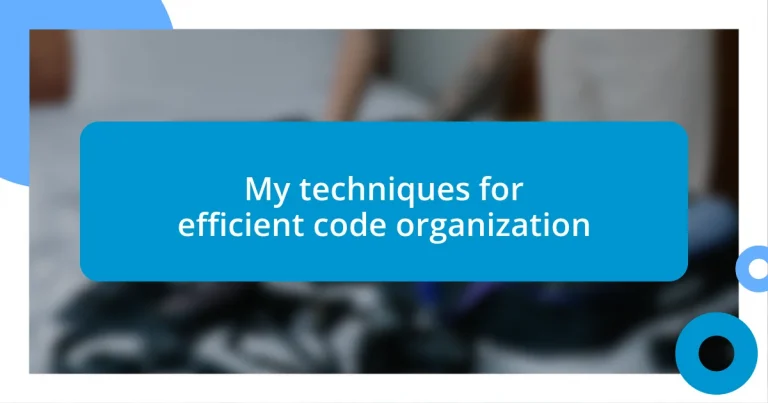Key takeaways:
- Effective code organization techniques, such as modular programming and consistent naming conventions, significantly enhance readability, debugging, and collaboration.
- Leveraging version control systems, like Git, allows for safer experimentation, facilitates team collaboration, and improves documentation of coding processes.
- Organizing files and directories logically, alongside fostering a supportive culture for code reviews, streamlines workflows and boosts team productivity.
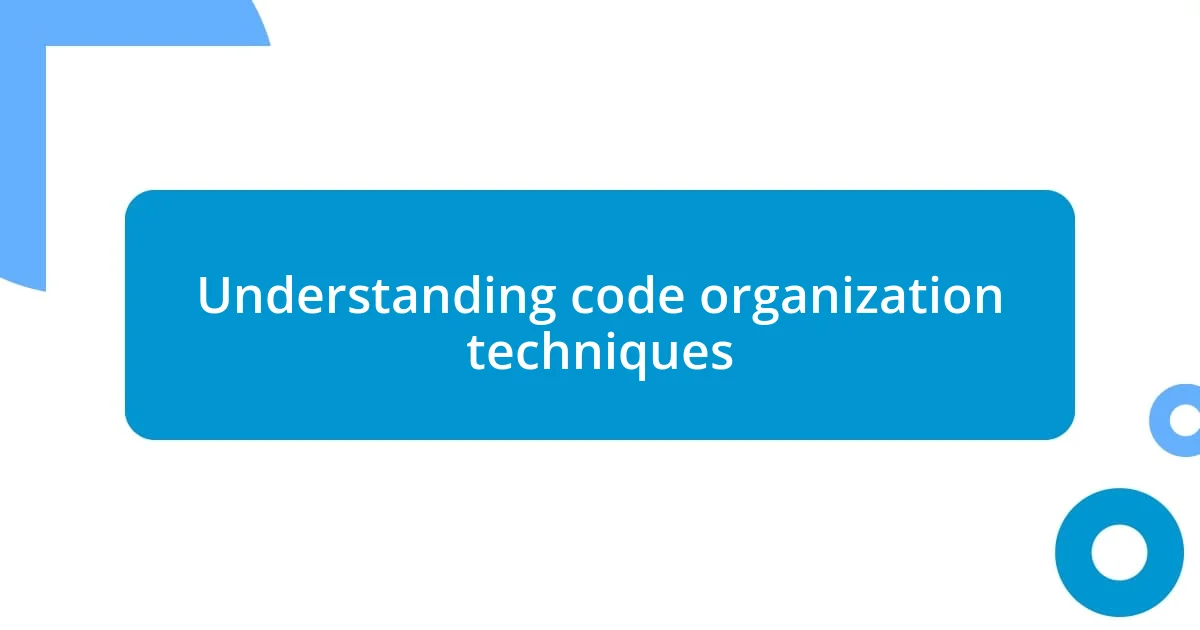
Understanding code organization techniques
When I first started coding, I often struggled to keep my projects organized. I remember one particular project where I spent hours sifting through tangled files and messy code just to find a single function. It hit me then: effective code organization isn’t just a nice-to-have; it’s essential for maintaining sanity and productivity.
There are several techniques that can drastically improve your code organization. From using descriptive naming conventions for variables to structuring files logically, each choice you make impacts your workflow. It makes me wonder, have you ever spent time refactoring; if so, how did it feel to see everything fall neatly into place afterward? The satisfaction of knowing where everything is supposed to be can be incredibly rewarding.
Another method that has worked wonders for me is the practice of modular programming. By breaking down my code into smaller, manageable components, I not only enhanced readability but also made debugging significantly easier. There’s a certain level of freedom that comes from knowing you can isolate a function without the added worry of disrupting the entire project—what could that level of clarity do for your coding experience?
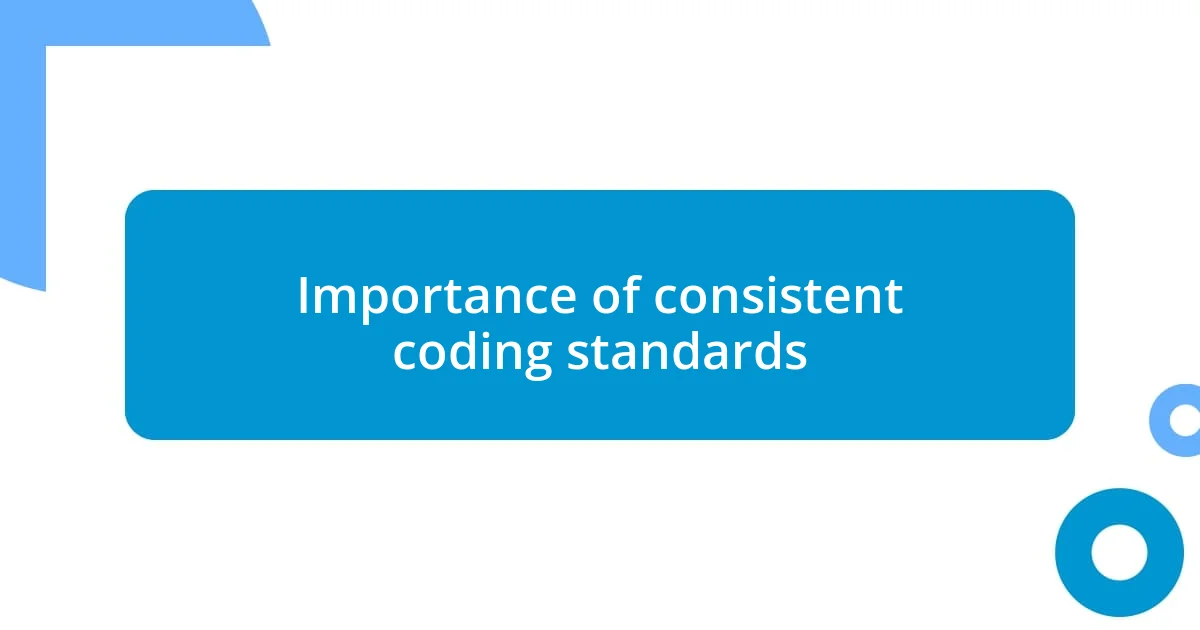
Importance of consistent coding standards
Consistent coding standards create a common language among developers. I can’t tell you how many times I’ve encountered code written by others that didn’t follow the same guidelines. It can feel like trying to decipher a foreign dialect. However, when everyone adheres to a cohesive standard, collaboration becomes seamless. It’s like being part of a team where everyone understands the play, making it easier to jump into projects without wasting time figuring out someone else’s style.
I’ve noticed that when I adopt consistent coding standards, my own code readability improves drastically. I remember a project where I was the only developer; I decided to implement strict naming conventions and code formatting. Looking back, it felt incredibly rewarding to navigate through my own files without confusion. It was like stepping into a well-organized library where every book is arranged perfectly. It not only reduced my stress, but it also sped up my debugging process, allowing me to focus on creativity rather than searching for misplaced elements.
Consistency in coding standards also plays a vital role in maintaining long-term projects. I once inherited a codebase that was all over the place—different styles, formats, and naming conventions scattered throughout. It was overwhelming! Establishing a uniform standard in that scenario felt like putting on a seatbelt during a wild ride; suddenly, things began to stabilize. Whenever I return to that project, I can easily identify bugs and make enhancements without the headache of deciphering someone else’s mess.
| Pros of Consistent Coding Standards | Cons of Inconsistent Coding Standards |
|---|---|
| Improves team collaboration | Increases confusion and frustration |
| Enhances code readability | Slows down the development process |
| Facilitates easier debugging | Encourages technical debt |
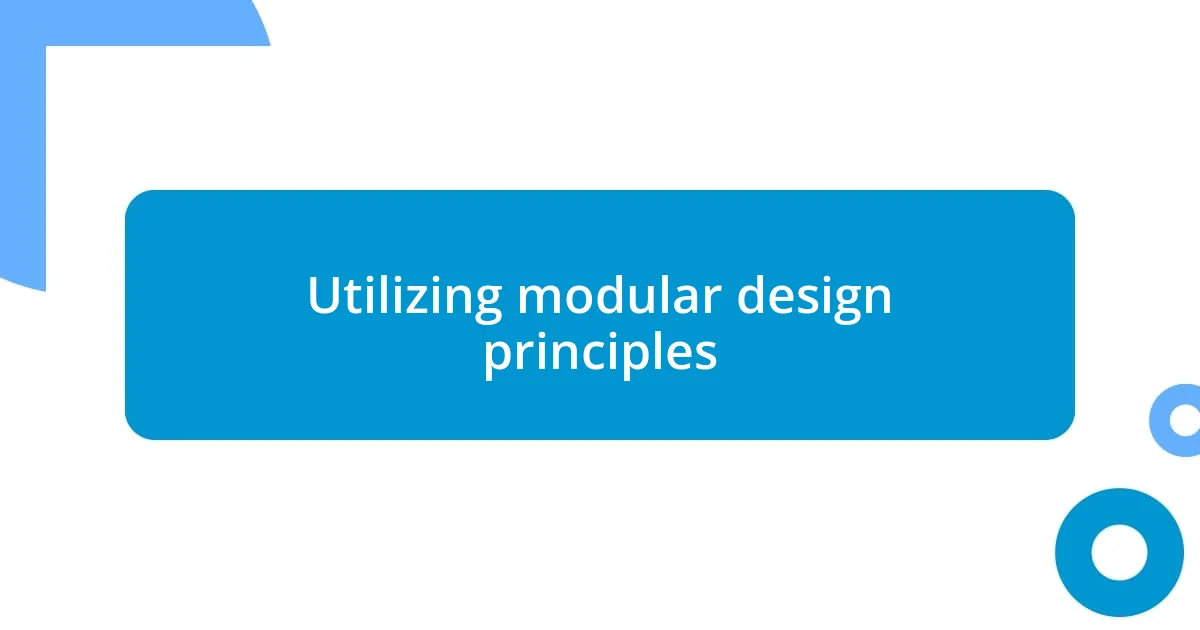
Utilizing modular design principles
When I decided to embrace modular design principles, it felt like unlocking a new level of creativity in my coding. Each module became a little world of its own, with functions and classes neatly packed, ready to play nicely with others. I vividly remember working on a large-scale application where I divided the project into distinct modules for user authentication, data processing, and UI. This approach not only simplified testing but also allowed me to collaborate effectively with teammates by focusing on their respective modules without getting overwhelmed by the entire codebase.
Here are some key benefits I’ve experienced from using modular design principles:
- Improved Reusability: Functions or modules can easily be reused across different projects, saving time in future developments.
- Easier Debugging: Tracking down issues is a breeze when you can isolate a problem to a specific module rather than hunting through a massive code file.
- Enhanced Collaboration: Teams can work on separate modules simultaneously, increasing productivity and reducing merge conflicts.
- Clearer Structure: It provides a logical structure for the project, helping both the developer and future collaborators understand the code at a glance.
I remember when my colleagues and I integrated new features into an existing system; because we used modular design, it felt as if we were simply adding bricks to a sturdy wall rather than trying to redraft the whole thing. This not only boosted my confidence but also fostered a sense of pride in how organized our codebase had become. It transformed coding from a daunting task into an enjoyable puzzle.
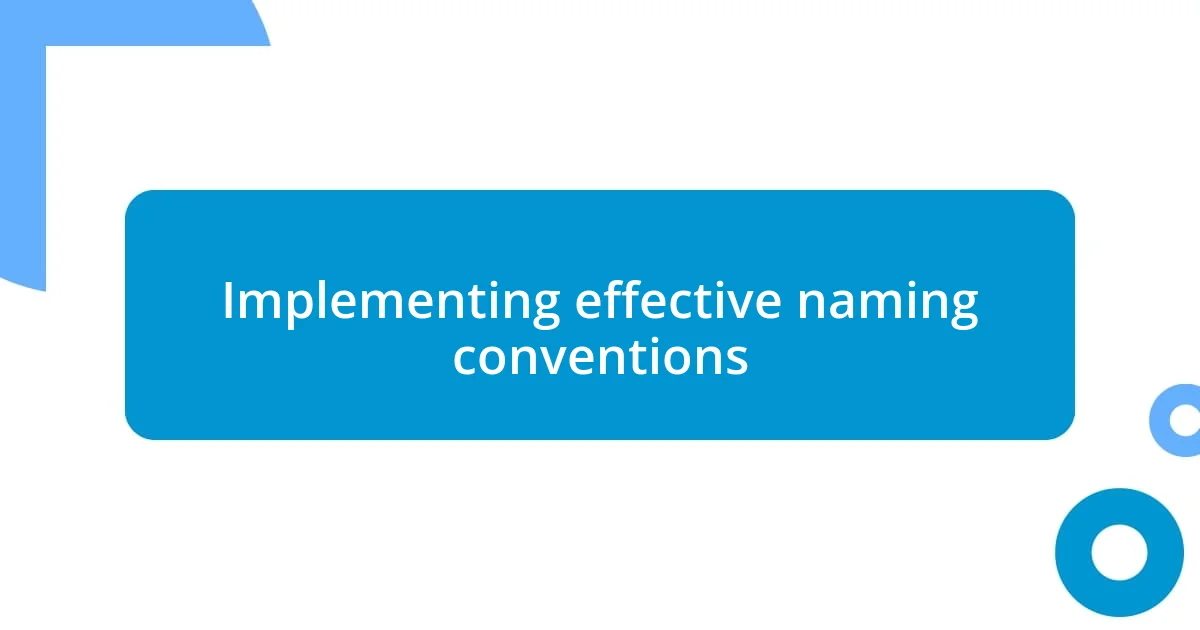
Implementing effective naming conventions
When it comes to naming conventions, I’ve learned through experience that clarity is key. For instance, I once worked on a project where variable names like x and data1 were prevalent. It drove me nuts—it was like wading through molasses just to figure out what each piece of code did. However, by switching to descriptive names, such as userLogin or orderTotal, I found that my understanding of the code improved dramatically. It was like discovering a map in a maze; suddenly, the way forward was clear.
I also discovered that consistency in naming is paramount across the entire project. During a collaborative project, my teammates and I agreed on naming patterns for our functions and variables. This approach not only strengthened our code’s cohesion but also made onboarding new developers much smoother. I remember one developer joining the team, and their initial reaction was delight at how intuitive the code structure felt. It made me realize how effective naming conventions can transform a chaotic environment into a well-oiled machine.
Moreover, I believe that using established naming conventions—like camelCase or snake_case—can save countless hours of confusion. I’ve found that adhering to these standards isn’t just about aesthetics; it helps in creating expectations around how code behaves. Think about it: if you see a function called calculateTax, you intuitively understand what it does. It’s almost like having a universal language in coding; when we all play by the same rules, everything flows more smoothly. Have you ever faced an instance where poor naming conventions derailed your understanding of the code? It can be quite a frustrating experience, reinforcing just how vital this practice is to overall efficiency.
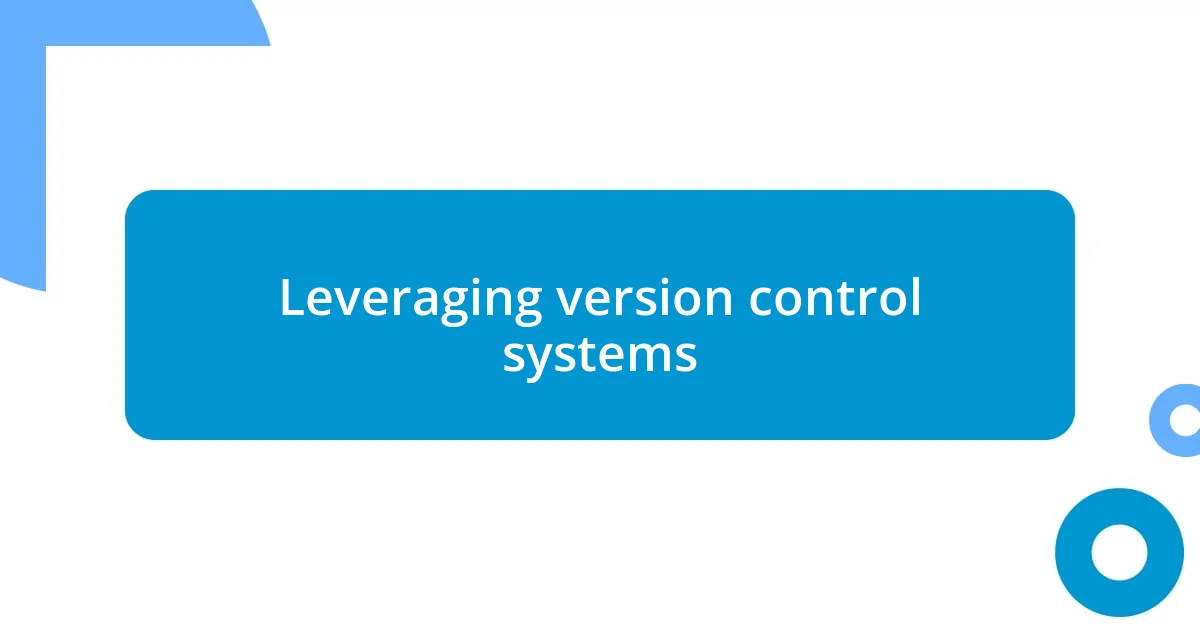
Leveraging version control systems
When it comes to leveraging version control systems, they have truly transformed my workflow. I still remember my first encounter with Git; it felt like learning to ride a bike for the first time. Once I grasped the basics of commits and branches, I could revisit previous versions of my projects with ease. Suddenly, the anxiety of making mistakes diminished as I realized I could safely experiment without the risk of losing my progress. Can you recall a time you felt the weight of responsibility when coding? Version control can lighten that load significantly.
Working collaboratively on code is where version control really shines for me. I’ve participated in numerous group projects where Git’s branching feature became the lifeline of our team dynamics. We could each tackle different features independently, merging our work seamlessly later. I vividly recall a particular project where we had to deal with conflicting edits. Thanks to branching and the ability to revert to earlier states, we tackled those conflicts head-on like seasoned pros. Have you ever felt overwhelmed by merge conflicts? It’s fascinating how a good version control system can turn what used to be a headache into a manageable process.
Additionally, I’ve found that utilizing version control effectively fosters better documentation of my coding journey. Each commit serves as a snapshot encapsulating my thought process at that moment. It’s almost like keeping a diary of my programming adventures. The other day, I had to recall how I implemented a specific feature several months ago, and all it took was a quick glance at my commit messages to jog my memory. Isn’t it refreshing to have such clarity in your creative process? Having that historical context not only aids my future self but also helps teammates understand the evolution of the project. It’s a game changer for keeping everyone aligned and informed.

Organizing files and directories
When it comes to organizing files and directories, I’ve discovered that a well-structured layout can save a ton of time and headaches. For instance, I once worked on a project that had everything jumbled together—scripts mixed with images and documentation all scattered around. Navigating that mess was like trying to find a needle in a haystack! Now, I always create separate directories based on functionality (like components, assets, and docs), which helps me locate files quickly and keeps my projects tidy.
I also learned the value of keeping a logical hierarchy. On one project, I split my directories into main categories and subcategories, which made everything intuitive. I remember the satisfaction of adding a new feature, knowing exactly where the relevant files were. Have you ever felt the frustration of not finding a file when you needed it? By organizing directories by purpose—say, separating src from test—it becomes almost second nature to navigate the codebase efficiently.
Furthermore, implementing a consistent structure across my projects has been a game changer. I recently worked with a team on a large application, and we agreed on a common organization format. It was exhilarating to see everyone’s files in sync; onboarding new team members was seamless, almost like welcoming them into a familiar space. Do you remember a project where disparate file arrangements led to confusion? I’ve learned that a shared directory organization fosters collaboration and keeps everyone on the same page, making coding a more enjoyable experience overall.
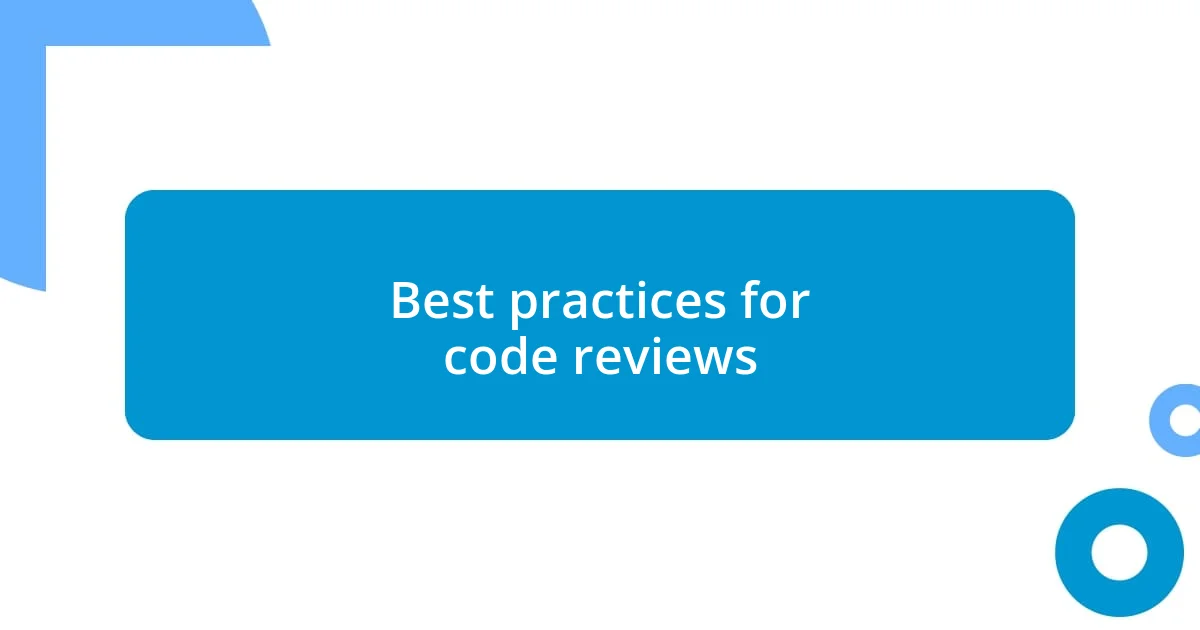
Best practices for code reviews
When it comes to code reviews, I’ve found that creating an open atmosphere is essential. I remember a project where the team was hesitant to critique each other’s work, leading to missed mistakes and a strained dynamic. I realized that establishing a culture where feedback is viewed as an opportunity for growth helped everyone feel more comfortable and willing to share insights. Have you ever been in a situation where fear of judgment stifled honest feedback? I know that feeling all too well, and fostering a supportive environment made a world of difference.
It’s also crucial to set clear guidelines before diving into a code review. In my experience, having a checklist that outlines key areas to focus on—like readability, efficiency, and adherence to coding standards—streamlines the process significantly. I recall a time when my team reviewed a particularly complex piece of code, and having that checklist in hand kept us on track, avoiding distractions. Do you find it easier to focus when there’s a tangible structure to follow? I do, and that structure empowers us to provide constructive feedback rather than getting lost in the code’s intricacies.
Lastly, I’ve discovered the power of pairing up for reviews. Whenever I review code with a partner, it not only enhances the quality of feedback but also fosters camaraderie. I remember when a colleague and I tackled a challenging review together; sharing perspectives led to discovering issues we might have missed individually. It makes the process more engaging and enjoyable. Have you ever thought how collaboration might elevate the quality of code reviews? From my experience, it can turn an otherwise solitary task into a team-building exercise that strengthens both the code and the team.












